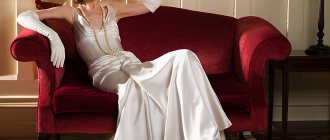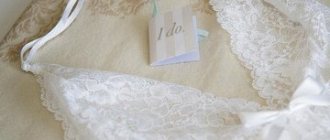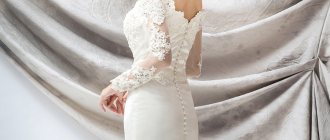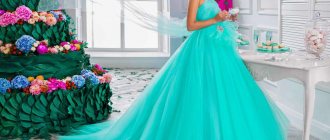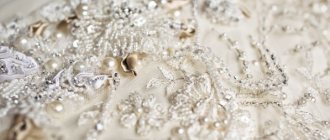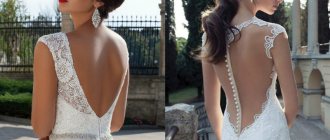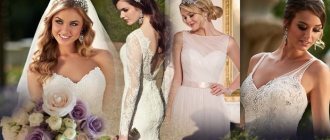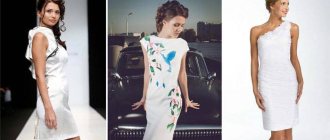Brides of all times wanted to be the most beautiful at their wedding and strived to have a unique outfit. Fashion has changed over the centuries, and each of its revolutions left unique wedding dresses in the memory. But time goes by in a spiral.
And already today, fashion features of the Middle Ages and the Age of Enlightenment are appearing, and the wedding dress of the 19th century sets the tone for many designer collections. And this is not surprising, because knowing the trends of the past, you can create a unique image and hold a unique wedding ceremony, so let’s open the pages of history.
Antique wedding dress
The concept “ancient” takes us back two or three historical centuries.
Wedding dresses of those eras were seriously different in style from modern ones, and the color schemes were most often not snow-white at all. Since weddings in those days were rarely of a love nature, but more of a commercial nature, the bride’s dress reflected the wealth of her family and had to correspond to the social status of her future husband. These are expensive, usually refined and expensive materials brought from abroad: silk, satin, corduroy, velvet. Photo of a 19th century retro wedding dress
Wedding dresses in medieval style
Gold and pearl threads, the finest handmade lace, precious stones (emeralds, sapphires, rubies), and rich fur (mink or sable) were chosen as decoration.
The moral principles of that era dictated their own rules: dresses for the bride were closed, the chest and neck were not exposed, the hem was certainly “floor-length” and sleeves were of maximum length. The color of the wedding dress directly indicated the financial well-being of the bride’s family: materials for dresses dyed with natural pigments were expensive, and therefore only girls from a rich family could afford bright models in scarlet, pink or blue.
Natural colors of wedding dresses (milk, beige, natural linen) remained the lot of poor brides; fur decor consisted of hare or fox skins. When choosing an antique dress now, it is worth considering these symbolic moments.
Photo of a wedding dress in a medieval style
In families of modest financial means, wedding dresses were made with the expectation that in the future such an outfit could be worn on any significant occasion. By modern standards, such a wedding dress will seem too practical and rustic, so designers usually use old styles, but make them from expensive textured fabrics with spectacular decoration.
Color
A white classic wedding dress is traditional. This color is symbolic as it signifies the purity and purity of the bride. However, the snow-white shade does not suit everyone. He makes some girls pale.
Those brides for whom cold shades of white do not suit (and these are, as a rule, representatives of the “autumn” and “spring” color types) should choose classic outfits in warmer shades of this color. Wedding classics include ivory, splashes of champagne, ivory, and cream.
But shades of other colors, including pastels, are considered a departure from the classic style. The use of bright colors, including in the form of decoration or accessories, is no longer a classic.
Photo selection of beautiful vintage bridesmaid dresses
Modern wedding dresses can look very different, because the choice of materials is unusually large, and the imagination of brides has no limits. Often girls prefer to return to the roots of fashion, ordering outfits that resemble ancient wedding dresses. If you also dream of such a wedding dress, look at the photo selection below, which presents beautiful wedding dresses made in a retro style.
The 40s and their charm
The post-war years could not be called easy; brides could not boast of rich fabrics or decoration, but the silhouettes of wedding dresses delighted with grace and femininity. Tulle, chiffon, organza - light fabrics are in fashion. During this period, a new trend began to emerge, the so-called new look - ankle-length models, full skirts, a pronounced waist, and a closed neckline. Most of the dresses were with long sleeves - it was difficult for ladies to overcome conservatism, but now every bride will be able to choose the ideal model according to all criteria.
Wedding suits were also popular; after the appearance of trouser suits, more and more ladies wanted to try them on, some chose them for their wedding day, complementing them with elegant accessories and a suitable hairstyle.
Wedding
The main pre-wedding moment of the 19th century was the wedding, that is, the union of two loving hearts with a heavenly blessing. On the wedding day, the groom, through a matchmaker or aunt, sent the bride a “groom’s box” with gifts and wedding accessories - a veil, wedding rings, wedding candles, perfume, pins. Having received the gift, the bride's aunt began to dress the young woman for the wedding.
Before getting married, they compiled a “Marriage Search”
. They collected evidence that confirmed that the bride and groom were not related, were married, and were “of good mind and sober memory.” Weddings that took place on Pokrov were considered the happiest.
Wedding decorations. Russian empire. Early 20th century
Story
It is difficult to say when straight-cut wedding dresses first appeared. Since this is the simplest cut, outfits of this type were sewn by our distant ancestors. The history of fashion has preserved information about straight tunic dresses worn by brides in Ancient Egypt. Similar wedding dresses were traditional among most peoples. As a rule, various embroidery techniques were used for decoration.
In modern fashion, wedding dresses with a straight silhouette appeared at the beginning of the 20th century, thanks to the fashionable tailor of that time, Mario Fortuny. They were presented with a wedding toilet, which the fashion designer called Delphonse. He looked so unusual that he created a real sensation. The designer invited brides to “free themselves” from tight corsets and fluffy skirts, putting on comfortable straight dresses made from softly flowing fabrics.
The silhouette of the dress is a regular rectangle; draperies and soft folds are used for decoration. As a result, the bride in such a dress becomes like an ancient goddess. The dress visually elongates the silhouette, so the bride appears slimmer and taller.
Lace
In England there is a sign that on her wedding day the bride should wear “Something old and something new, something borrowed and something blue.” .
Something old is lace that was passed down from grandmothers. They were very expensive - some were more expensive than gold. The wedding dress of American actress Grace Kelly (she got married in 1956) was decorated with lace that was more than 100 years old. Lace is well preserved, so you can often find whole lace from unpreserved dresses in antique shops.
New is jewelry given by the groom. Queen Victoria, seven years after the wedding, commissioned a portrait in which she was depicted in a wedding dress and a brooch, which her husband gave her.
As for borrowing, it was considered a good omen to borrow something from a friend, and something blue was a tribute to the old fashion, when dresses of this color were popular. It was believed that blue was a heavenly color, the color of the Virgin Mary, and it was sure to bring happiness.
The lace was woven using special devices - bobbins.
. The portrait of “The Lacemaker” by Tropinin depicts French bobbins, since, most likely, the lacemaker worked for the nobles. Of the Russian laces, we know only those from Vologda, although there were many lace-making centers. Even if our lacemakers made thin, beautiful lace, it was still put in a French box and passed off as foreign - it was believed that it was better than Russian.
Tropinin A.V. "The Lacemaker"
The most magnificent dress
The wedding dress of the British Princess Diana turned the heads of millions of girls around the world, and under its influence, the fashion for lush wedding dresses with a huge amount of decor continued for at least a couple of decades. What can I say, many brides still dream of just such a princess dress, with lace, embroidery, frills, a full skirt, and a long, long train. Diana's dress was made of silk taffeta, the length of its train was almost eight (!) meters, and vintage handmade lace and pearls were used in the decor.
Perhaps such a dress looked appropriate at a royal wedding and against the backdrop of rich interiors. But today, wedding stylists and designers clearly do not approve of the “all at once” approach. The modern bride is advised to choose one accent so as not to look like a “meringue” - this is the word critics called Diana’s dress.
Wedding date: July 29, 1981.
Designers: David and Elizabeth Emanuel.
Cost: Sold at auction for $175 million.
Wedding fashion of the 30s
The outfits of those years are real luxury and amazing elegance. If a decade ago it was not fashionable to emphasize the waist, now models have again acquired seductive curves. Material – often chiffon and silk, less often lace. The silhouette should be flowing, multi-layering, all kinds of draperies, folds, and asymmetrical cut look impressive. The neckline is small, deliberately modest; either a train or a hat with lace brim can be used as a headdress. Be sure to pick up original gloves, a string of pearls, a small clutch bag - and voila, the image of a socialite is ready!
And a few more princess wedding dresses:
Josephine of Leuchtenberg, future Queen of Sweden, Oscar of Sweden and their wedding costumes in 1823
The most beautiful queen in Europe, Elisabeth of Bavaria, Empress of Austria, married to Franz Joseph I. Her wedding dress from 1854
Alexandra of Edinburgh, daughter of Maria Alexandrovna and granddaughter of Alexander II. Her wedding dress from 1896
Alexandrine of Mecklenburg-Schwerin, future Queen of Denmark, her fiancé Christian of Denmark 1898. Wedding costumes are in the Amalienborg Museum
Emma of Waldeck-Pyrmont, Queen of the Netherlands with her husband Willem III. Wedding dress 1879
German Princess Elisabeth Auguste Marie Agnes of Saxe-Altenburg, Russian Grand Duchess Elizaveta Mavrikievna, wife of the Russian Grand Duke Konstantin Konstantinovich 1884
Empress Alexandra Feodorovna's wedding dress – 10 kilograms of silver brocade, marabou feathers, elegant embroidery.
Ermine robe included with the dress
Empress Alexandra Feodorovna
11 options for transforming a wedding dress
Veil
This is interesting!
The tradition of wrapping the bride in a thick blanket appeared in Ancient Greece and Rome. It was believed that the veil would protect the bride from the unkind glances of envious people, the evil eye and damage. Later the veil was transformed into a long veil. It was believed that the future spouse could see the face of the chosen one only after the wedding, and the bride’s face was covered with a veil so that the groom would not change his mind after seeing the appearance of his future wife.
Cape, Belgium. XVIII century
In addition to the veil, there were other wedding accessories in the 19th century. One of them is a mother-of-pearl fan with galloping horsemen carved on it. A similar one is in the Hermitage collection - it was made for the wedding of Grand Duchess Maria Alexandrovna with the Duke of Edinburgh, which took place in 1874 in St. Petersburg. At the exhibition in Kolomenskoye, an almost identical fan is presented, only it depicts one dove instead of two. Perhaps the accessory was made for the wedding of someone from the royal family.
Plie` wedding fan “Bouquets of roses”. France. 1870s
Style
A classic dress can be full or not. A fluffy classic-style bride's dress is a princess-style outfit. Its main features:
Corset top. The corset can be a separate detail of the outfit, but more often, it is sewn with a skirt. The bodice of such a dress is decorated with embroidery, rhinestones, beads, and artificial pearls. The shoulders can remain completely open, but straps are often used. A closed dress with sleeves can also be sewn in a classic style. It also has a corset top, only the shoulders and arms will be covered. Lace fabric is often used to sew sleeves and the upper part of the bodice.
Waistline. In a classic outfit, the waistline is always emphasized, since the transition from the bodice to the skirt is very pronounced. A belt embroidered with beads or pearls is often used. Sometimes the belt is decorated with artificial flowers.
Skirt. The fullness of the skirt is achieved through the cut (using the “sun” or “bell” style) and the use of a multi-layer petticoat. The skirt can be sewn with hoops, which will add the necessary pomp to the outfit. To decorate a skirt, flounces, draperies, and folds are often used.
Plume. This detail is not a mandatory attribute of a dress in a classic style, but is used quite often. The train can have a length from 20 cm to infinity. However, the bride should take into account that the longer the train, the more difficult it will be for her to move. Much more comfortable are dresses in which the train can be unfastened or pinned to the skirt.
A classic style wedding dress does not have to be lavish. Fitted dresses with an A-shaped silhouette are also considered classics. This dress option is more suitable for plus-size brides. Since in a fluffy dress a plump bride will seem overweight.
What wedding dresses were fashionable in the 20th century?
At the beginning of the 20th century, wedding dresses with large skirts were no longer considered fashionable. They began to decorate them with so-called “crepes” - small wooden cones wrapped in lace. Wedding dresses were sewn so that even the bride's neck was covered. A stand-up collar was used for this. The length decreased, the edge of the skirt covered only the ankles. The corset was no longer a fashionable attribute, but from time to time it was used to highlight the silhouette and hide figure flaws.
50's style
In the middle of the last century, the popularity of the romantic style returned. Long skirts, cream tones, fragile slippers and dresses with slightly lowered waists came into fashion. These accents made it possible to visually transform the bride’s gait, making it light and airy. Dior became the trendsetter of fashion trends, and he began to sew fitted dresses with a voluminous skirt that reached approximately to the knees.
An enchanting breakthrough in the world of wedding fashion of the 50s was Grace Kelly's outfit. It’s hard to call her dress anything other than “masterpiece.” The famous American actress's outfit for her wedding to the Prince of Monaco took more than a thousand meters of transparent silk taffeta, as well as light Brussels rose lace (which was more than 120 years old at that time).
60s style
In the next decade, minimalism gained popularity. The length of the wedding dress decreased, it looked strict and laconic. The number of decorative details was minimal. The most popular were simple dresses of short length without any decorations - even without beads. Geometric lines had to be clearly visible in the style.
The skirts had an original shape - a bud, bell or flower. Many brides of that time walked down the aisle in a trapeze dress (with a tight-fitting top and an extended lower part of the robe). True, not all girls liked the mini outfit. But most of all, most celebrities and representatives of royal families did not want to follow the new fashion trend.
80s style
Finally, in the 80s of the last century, wedding dresses became very elegant. Designers widely used loose fit, exquisite lace and romantic ruffles. Decorative embroidery on wedding dresses was considered the latest fashion trend. And instead of veils, hats were often used. Towards the end of the 80s, a new trend appeared in wedding fashion - brides increasingly wore not even dresses, but trouser suits.
Wedding preparations
hen-party
In the 19th century, stag and hen parties were also held. Writer Maria Kamenskaya recalls that on the eve of the bachelorette party, the girls went to the bathhouse with the bride, and then sang wedding songs, drank, ate and danced. The bachelor party was more discreet
— the groom gathered his friends, and they had decorous conversations. Among the peasants, the bachelorette party was held differently: the girl was mourned, symbolizing her transition to a new status as a married woman.
Engraving "Dressing the Bride", Western Europe. Late 19th century
From the collection of G.V. Novikova
Dress
Until the 19th century, people in Europe got married in multi-colored dresses - red, green or blue. In Russia, the most elegant dress, fashionable among the nobility, was chosen for this purpose. But in 1840, Queen Victoria of England was getting ready to get married and suddenly decided to choose a white dress for the ceremony and decorate it with a veil and lace, thereby introducing this outfit into wedding fashion.
Portrait of Queen Victoria in her wedding dress
Dresses were ordered from Western Europe. Royal figures set the fashion, and the nobility, merchants and peasantry followed.
Wedding dress, Western Europe. 1914
There was no mass production back then, so everything was made to order. One of the dresses that can be seen at the exhibition was made in 1914 in New York, the shoes are made of a similar material. By the way, stockings were also sewn for this dress, and they were stored in special envelopes made of the same material.
Shoes to match the dress, New York. 1914 (From the collection of G.V. Novikova)
Dresses for various occasions
A 19th century woman changed her outfit several times a day, depending on the occasion.
Morning dresses.
In the morning dressing, the ladies went out to breakfast and met with their relatives. These were dresses of a simple cut, made of smooth fabric. The dress had long sleeves, a neckline, and the colors were subdued. They also wore shlafor at home - loose clothing with a wrap, a belt, and sometimes with pockets. Women did household chores there.
For morning visits, women wore graceful, elegant dresses, but not formal ones.
Ball dresses.
Ball gowns of the nineteenth century became real masterpieces. They were distinguished by luxury, splendor, and grace. Dresses for the ball are made from expensive fabrics: silk, taffeta, satin, poplin, moire, velvet. The trim on the dress gave it a feminine touch. The dress was decorated with:
- ruffles;
- fringe;
- soutache;
- drapery;
- bows;
- braid;
- pleating.
19th century ball gowns
The colors of ball gowns were plain, matte or shiny. Dresses for married ladies had a deep neckline; for unmarried girls it was not so deep, but with a neckline that emphasized the chest. The dress was complemented by long gloves, a fan and high-heeled shoes. Girls wore ball gowns in lighter colors; older ladies could afford to wear dresses of different colors. The dresses were luxurious and splendid.
1) Wedding dresses.
Empire style wedding dresses were discreet in color, most often white with embroidery or trim. They were sewn with a high waist.
They had a large neckline and short sleeves. This cut made it possible to emphasize a beautiful waist and chest and help hide figure flaws. Wedding dresses were made of satin, over which transparent fabric was placed. They were complemented by long gloves.
In the middle of the 19th century, wedding dresses acquired a fuller skirt and corset. They were decorated with bows and lace.
The period of bustles did not spare wedding dresses either. The back of the dress was decorated with flounces, frills and trains. At the end of the nineteenth century, wedding dresses were elegant, with a slightly flared skirt. Bows, bustles and embroidery are completely out of fashion. Wedding dresses emphasized the bride's femininity, innocence, dreaminess, and romance.
2) Winter dresses.
Ladies wore winter dresses for walks and at home. They were sewn from woolen fabrics, decorated with fur and embroidery. There were many woolen fabrics: merino, luxor, dradedam, barège, castor.
3) Provincial dresses.
The dresses of those living in the provinces were made from inexpensive fabrics and no less decorated; they wore the same styles as women in the capital. Dresses were made from linen, wool or cotton.
4) Dresses for carriage rides.
For travel and carriage rides, 19th-century ladies wore dresses that were practical and loose, and also shorter than usual. This version of the dress allowed its owner to comfortably get in and out of the carriage and not get dirty during travel. The colors of the travel dress were restrained, the fabrics were soft.
Crew Dress
5) Dresses of merchants.
Merchants' dresses differed from fashion trends. They were lush, but simple, so the merchant women decorated them with feathers, bows, flowers, embroidered with bugles, fringe, which overloaded the image.
6) Dresses of teachers and students.
Female students and teachers wore dresses of a strict cut, dark colors with a white collar. The length of the skirt reached the ankles, the bodice was decorated with a peplum. The dresses of such ladies were made of wool, linen, and cotton.
7) Dresses for working women.
The outfits of working women did not differ from generally accepted fashion. But they were without decorations, draperies or bustles. For work, dresses were made from cotton and chintz, for holidays - from silk, but cheaper.
Fashion of the 19th century was constantly changing, introducing something new and unexpected. At the same time, all styles were distinguished by elegance, femininity, luxury and grace.
Dowry
On the day of the engagement, a document “Dowry Listing” was drawn up, in which they described what the bride had - images, fur coats, bonnets, chests, jewelry. The dowry was prepared in advance and sent to the groom's house in several carriages.
This is interesting!
Elizaveta Ivanovna Benardaki, from a family of the first millionaires in Russia who started in Taganrog, helped some brides with dowries so that they would get married successfully.
Historians write that she bequeathed “to deposit 10 thousand rubles
so that interest on this capital would be given once a year to five poor brides in the city of Taganrog, mainly from the Greeks.”
Russia. 1885, April. Dowry painting
Matchmaking did not always go smoothly - the parents might not like the groom or his status. There were cases when the wedding almost took place, but at the last minute it became known that the groom was a relative of the bride or was already married.
“...she didn’t like the first one herself, the second one was not in rank and the mother didn’t like it, the third one was liked by both of them very much, the betrothal had already been made, and the wedding day had been set, but the day before, to their surprise, they learned that he was their in close relatives, everything was upset...”
Vladimir Odoevsky, story “Princess Mimi”
Wedding fashion
The most terrible wedding dresses of stars abroad and in Russia
What celebrity wedding dresses can be called the most terrible? We have prepared for you a selection of photos of the most ridiculous celebrity wedding dresses that completely ruined their festive look.
- 4354 views
- 15 photos
Wedding images of stars: photos and ideas for inspiration
Stars’ wedding dresses and images in general remain in the public’s ear for a long time, and their photos inspire thousands of brides to create a memorable wedding look. Let's look at a few images of famous brides in recent years.
- 564 views
- 12 photos
Badgley Mischka
Year of origin: 1988
Founders: Mark Badgley and James Mischka are classmates at New York's Parsons School of Design. And if Badgley immediately decided on his choice of profession, then Mishka got into the fashion industry, having previously trained as a bioengineer. While still at Parsons, the designers decided to create a joint brand, but realized their dream only a few years after graduation, having gained experience working in large fashion houses.
Brand: Having founded their brand in 1988, Badgley and Mishka released their first collection of wedding dresses only five years later - in 1993. Designers say that their main inspiration is the golden era of Hollywood and the style of its main icons - such as Marilyn Monroe and Rita Hayworth.
Badgley Mischka dresses are distinguished by simple streamlined shapes, the absence of a large number of decorative elements and baroque abundance. Their outfits will appeal to brides who value comfort and convenience, but do not want to sacrifice beauty and elegance. In their collections, Badgley Mischka rarely strays away from the classic white color, only occasionally adding models in beige, cream or ivory.
Celebrity Clients: Celebrities who have chosen a Mark Badgley and James Mischka gown for their wedding include Jada Pinkett Smith, Carmen Electra and Tori Spelling. In addition, the heroine of the TV series “Sex and the City,” Charlotte York, played by actress Kristin Davis, wore their dress.
Tori Spelling in Badgley Mischka dress
Amsale
Year of origin: 1985
Founder: Amsala Aberra was born in Ethiopia, after graduating from high school she flew to the United States to continue her education there. Due to the revolution that began in her homeland, Amsala was forced to stay in the States, where she began sewing clothes for herself because she could not afford to buy them in the store.
Brand: Starting the production of wedding dresses with one single model created for her own wedding, Amsala never dreamed that she would one day open a personalized boutique on Madison Avenue. Her business began with an advertisement in the newspaper - the girl offered custom tailoring of wedding dresses, the design and manufacture of which she did herself. In just a few years, Amsale has grown into one of America's largest wedding brands.
Dresses from Amsale are characterized by simple, clean lines, minimalism and restraint. The designer herself says that her professional motto has become the phrase “Modern forever,” by which she means a modern interpretation of the classics. Amsala often complements traditional white dresses with color accents - a soft blue belt or a lilac bow.
Celebrity clients: Amsala Aberra has created wedding dresses for actresses Anna Paquin, America Ferrera, Sarah Rue, and Alec Baldwin's wife Hilaria. In addition, her dresses made it onto the big screen - Amsale creations were worn by the heroines of the films “The Hangover” and “27 Weddings.”
Anna Paquin in Amsale dress
Styles
Nineteenth-century dresses responded to and changed according to new artistic trends.
19th century casual dress
At the beginning of the 19th century, dresses in the Rococo style, which was popular in the 18th century, were replaced by Empire styles. They were lightweight, high-waisted, low-cut, with a ribbon under the bust, and a loose, pleated skirt. The dress was sewn long, with puffed sleeves or sleeveless. Expensive fabrics were used: silk, rep, wool, satin, damask, velvet. The colors were predominantly white, blue and red.
In 1820-1825, the skirt was transformed into a bell shape, and the waist began to be “shackled” into a corset.
When Queen Victoria of England ascended the throne, romanticism came into fashion. Images of women became dreamy and sublime. Dresses of the 19th century were distinguished by a skirt with a crinoline, an elegant corset was created for the waist, and the sleeves became puffy, wide, and framed. The crinoline was made of metal rods or horsehair. With him, the women even moved more gracefully, as if they were proudly floating around the hall.
Closer to the sixties, fashion changed again: dresses began to be decorated with scallops, ribbons, lace, borders, teeth - the bodice of the dress ended with a peplum. The sleeves were narrow, widening closer to the bottom, and the edges were decorated with lace cuffs. Crinoline was worn until the end of 1860; its shape also underwent changes, as dresses took up a large space, and the hoops became oval. The cut of the dress has also changed. The excess length of the skirt lay loosely on the crinoline, the length no longer covered the ankles. The skirt had two or three flounces.
In the 1870-1880s, dresses with bustles appeared - this is a pillow-shaped device with which ladies made their buttocks more voluminous. In the same place, the dress was decorated with ruffles, draperies, and folds. The dresses were decorated with embroidery, ruffles, and lace. Sewn from taffeta, they were decorated with bows and silk laces. A lace-up corset was worn under the dress. Vintage dresses from the eighties symbolized wealth and prosperity.
At the end of the 19th century, the bustle went out of fashion. Dresses were made of velvet, sometimes silk. S-shaped silhouettes have come into fashion.
The fabric of the dress mainly depended on where it was to be worn. Summer dresses were lightweight; they were made from light fabrics - silk, cambric. Ceremonial dresses were made of taffeta, satin, and velvet. Dresses for visits were made of light wool.
19th century wedding dress
Dresses for children and young girls.
At that time, little boys were also dressed in dresses. And when they grew up, they exchanged “girlish” clothes for trousers.
The fashion of children's dresses was completely copied from the fashion of adult dresses. The only difference was the length. The older the girl became, the longer the dress was made. Girls of four years old wore knee-length dresses, at twelve years old the length reached mid-calf, but at sixteen the dress was ankle-length. During the period when crinoline was in fashion, girls also had to wear it. Checkered or nautical colors were popular for children.
Teenage fashion closely imitated the clothing of the older generation. The girls also wore a corset, but not too tight. The dresses of young beauties copied every change in adult fashion. At the end of the 19th century, girls were allowed to wear dresses made of soft and light fabrics.
Acquaintance
Usually the bride and groom met at a ball. In the first half of the 19th century, the trendsetter of balls in Moscow was Maria Ivanovna Rimskaya-Korsakova. She organized evenings almost every day - every self-respecting nobleman attended them, even Pushkin visited her. So Rimskaya-Korsakova tried to find a suitable match for her daughters.
And, of course, girls had to dress fashionably (in order to get married more successfully). White dresses were popular at balls. Gloves, mostly long, were a mandatory accessory - it was considered indecent to offer a hand without gloves. It was impossible to talk with young people, so the girls communicated with the help of a fan. A fully open fan meant that the girl was delighted with the boy, a closed one meant that she was indifferent to him. In addition, the girl could leave a scarf for the gentleman as a souvenir, “accidentally” throwing it away.
Early 20th century
The beginning of the 20th century in women's wedding fashion was marked by a complete abandonment of fluffy multi-layered skirts and the use of crinoline. More and more, a wedding outfit is becoming similar to a classic dress: a fitted silhouette with a wide hem, a closed style with long sleeves, no neckline - even the neck is covered with a high stand-up collar.
Photo of a dress for a bride from the early 20th century
The length of the dress is not as dramatic as before: now not only the toe of the shoe is visible, but also the graceful ankle. Seamstresses of that time began to abandon the widespread use of a corset in the style, but sometimes it is present in designs - it allows you to visually make the figure slimmer, lift the chest, straighten your posture, and create a clearer silhouette.
Matchmaking
After meeting, the groom came to the bride’s house with gifts to get married. Usually it was a box with jewelry - gold bracelets, earrings, hat pins. The groom tried in every possible way to show his affection and status.
Bracelet
: Russia.
Last quarter of the 19th - beginning of the 20th centuries, gold, quartz, chrysoprase; carving (State Historical Museum) Ring
: Western Europe, Russia, Moscow.
Early 20th century, gold, emeralds, diamonds, cut diamonds (State Historical Museum) Earrings
: Russia. Early 20th century, Gold, diamonds, pearls (State Historical Museum)
Another important part of preparing for a wedding is the blessing of the parents.
. Guests were invited to this event: friends and relatives. Usually the blessing was performed with an icon of the Savior, the Kazan Mother of God, or another image especially revered in the family - it was believed that the marriage would be happy and the offspring healthy.
“Now parents more often learn about the decision to get married as a fact,” says Olga.

